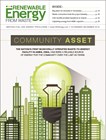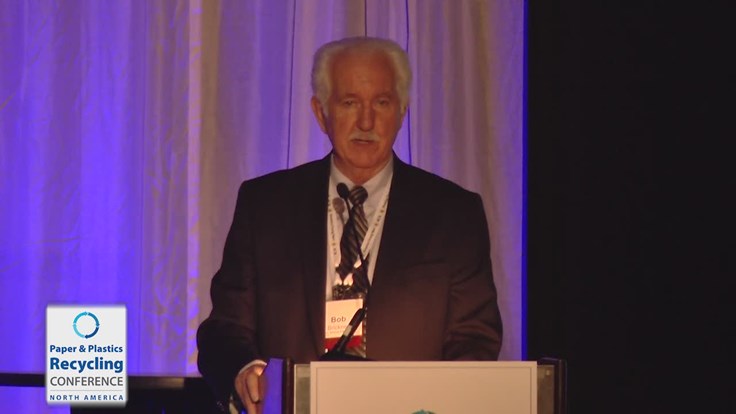Pictured, from left: Jeff Koerner, Florida Department of Environmental Protection; Ted Michaels, Energy Recovery Council; Mark Hammond, Solid Waste Authority of Palm Beach County; and Thomas Yonge, Golder Associates.
Florida’s progressive attitude toward waste-to-energy (WTE) projects is just one of many factors behind the success of anaerobic digestion, gasification and landfill gas projects in the state, according to speakers at the 2015 Renewable Energy from Waste Conference, hosted by Renewable Energy from Waste magazine and GBB Inc. Nov. 16-19 in Orlando, Florida.
“Some states have decided waste to energy is not a priority,” said Mark Hammond of the Solid Waste Authority of Palm Beach County in Florida. “Florida is very progressive.”
The Solid Waste Authority of Palm Beach County’s integrated waste management system includes two WTE facilities, landfills, vegetation processing, a recovered materials processing facility, ferrous processing, household hazardous waste collection, six transfer stations, a biosolids pelletization facility and landfill gas recovery.
The county processes 2.15 million tons of solid waste annually, approximately 6,000 tons per day. It has a total WTE capacity of 5,000 tons per day and recycles 136,000 tons of material annual from its residential and commercial customers, Hammond said.
The authority recently completed construction of its second WTE facility, a 3,000-ton-per-day mass burn plant. Hammond said it was a 10-year process from planning to completion and involved and “extensive” permitting process that included a dredge and fill permit, a storm water construction permit and air construction permit. The permitting process began in April 2009 and the final permit was obtained in April of 2015, he said. Hammond also added that the air permit was modified three times throughout the project.
The authority’s second WTE facility is the first of its kind in the U.S. to use selective catalytic reduction because the state had a preference for this technology, Hammond said. He added that as a result of this technology, emissions went down in all cases, and in some cases the reductions were quite significant.
“Waste to energy works in Florida because of the favorable regulatory climate,” Hammond said, adding, “I’d doubt I’d ever get one of these built in the state of California.”
He said Florida has a history of successful WTE operations and that the public perception of WTE more positive than that of landfilling as it is seen as being more environmentally friendly.
Hammond attributed some of the Solid Waste Authority of Palm Beach County’s success with its recent project to the two years of public outreach, which led to “little resistance” from the community.
He said the environmental impact of WTE suffers from misconceptions. “Nothing could be further from the truth,” Hammond added.
While he said the environmental community likely will continue to oppose WTE, “the proof is in the pudding” when these facilities are compared with landfills.
Thomas Yonge of Golder Associates’ Gainesville, Florida, office, in explaining why Florida represented a good place to site WTE projects, said, “I don’t work for the Florida Department of Commerce, but I am going to sound like I do.” He then mentioned the state’s population growth and climate as two factors contributing to the 1,100 tons of solid waste and the 10 billion of biomass generated in Florida annually.
From a waste conversion standpoint, Yonge said, some of this abundant material is processed at the 12 operating WTE facilities in the state as well as at the one commercial biofuel facility and the two private commercial scale anaerobic digesters.
Of Florida’s 22 publicly owned landfills, six have less than 10 years of capacity, Yonge said.
Advantages that can be realized by working with municipalities on WTE facilities in the state include flow control ordinances, local support, long-term agreements and co-location opportunities, he said. “If you can site a WTE plant at a landfill, you have many advantages,” he added.
Yonge said another factor influencing the adoption of WTE in Florida is that the state’s Department of Environmental Protection has a cooperative attitude and has streamline some regulations.
He advised other cities: “Make rules as strict as you need to, just make them clear.”
Outreach and communication were keys to the success WTE has found in Florida, Yonge said. “You must engage the community; it’s the only way to get things done in Florida.”
Jeff Koerner of the Florida Department of Environmental Protection Division of Air Resource Management in Tallahassee, said the state has 11 WTE plants with a total of 632 megawatts of capacity and 14 permitted landfill-gas-to-energy facilities with about 100 megawatts of capacity.
Florida has a goal to recycle 75 percent of its municipal solid waste (MSW) by 2020 and achieved its interim 50 percent recycling goal by 2015. Renewable energy counts toward the recycling rate in the state, Koerner said, noting that each ton of MSW used as a processed fuel, fuel or fuel substitute receives and 1 ton recycling credit, while each megawatt-hour generated by a WTE plant receives a 1 ton recycling credit. He added that if a county’s recycling rate was greater than or equal to 50 percent by means other than renewable energy, that country receives 1.25 tons per megawatt hour of electricity generated as a recycling credit.
Koerner recommended that attendees interested in citing WTE projects hold a preapplication meeting with the permitting authority. He also advised questioning and avoiding PSD (Prevention of Significant Deterioration, the purpose of which is to implement the Federal Clean Air Act requirements for the prevention of significant deterioration of air quality) applicability when possible, adding “but don’t know yourself out trying to avoid this.” He said PSD may be the fastest way to get permitted and may provide the most operational flexibility in the long term. However, he added that operations may want to consider a Continuous Emissions Monitoring System (CEMS) for the most flexibility.
“Florida has a time clock on permits,” Koerner said, adding that the state focuses on permit processing and that permitting a new facility takes priority over five-year reviews.
The Renewable Energy from Waste Conference was organized by Renewable Energy from Waste magazine, a publication of the Recycling Today Media Group, Valley View, Ohio, and GBB, Fairfax, Virginia. The event was at the Caribe Royale in Orlando.



